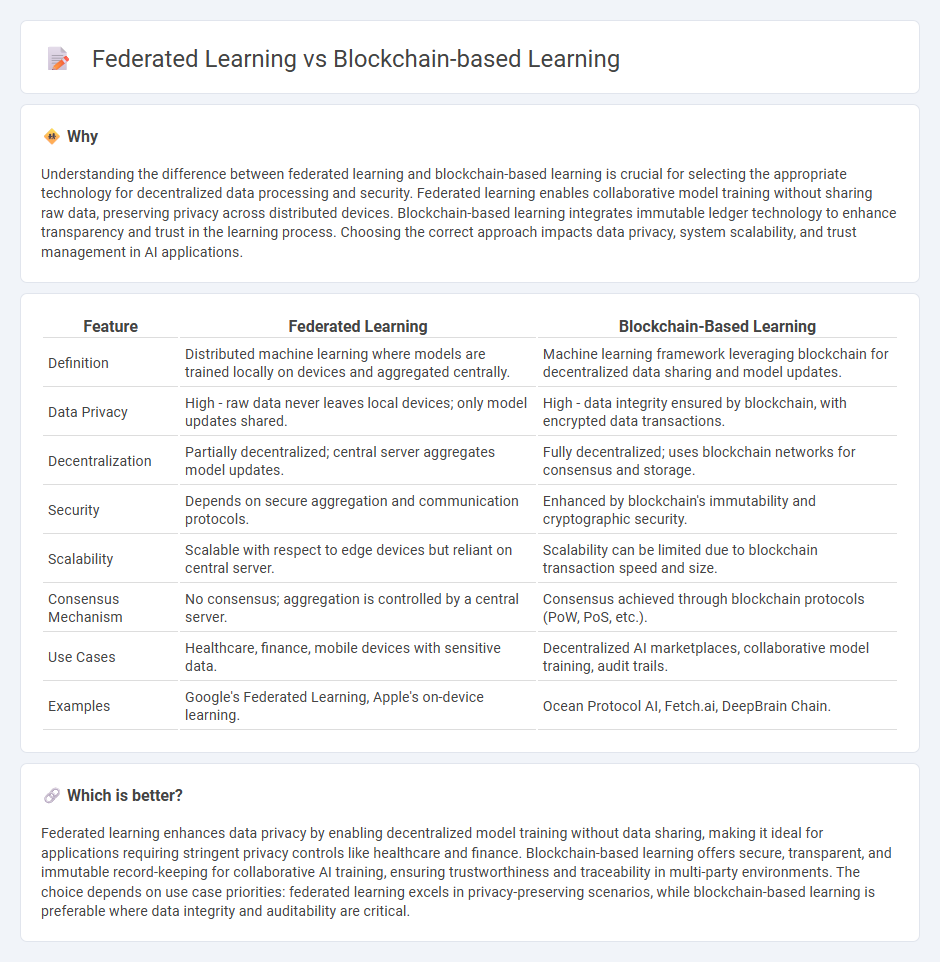
Federated learning enables decentralized model training by allowing devices to collaboratively learn without sharing raw data, enhancing privacy and reducing bandwidth usage. Blockchain-based learning integrates distributed ledger technology to ensure data integrity, transparency, and trust during the training process, making it ideal for environments requiring secure and auditable AI development. Explore the distinct benefits and applications of federated learning versus blockchain-based learning to understand their impact on future AI innovations.
Why it is important
Understanding the difference between federated learning and blockchain-based learning is crucial for selecting the appropriate technology for decentralized data processing and security. Federated learning enables collaborative model training without sharing raw data, preserving privacy across distributed devices. Blockchain-based learning integrates immutable ledger technology to enhance transparency and trust in the learning process. Choosing the correct approach impacts data privacy, system scalability, and trust management in AI applications.
Comparison Table
| Feature | Federated Learning | Blockchain-Based Learning |
|---|---|---|
| Definition | Distributed machine learning where models are trained locally on devices and aggregated centrally. | Machine learning framework leveraging blockchain for decentralized data sharing and model updates. |
| Data Privacy | High - raw data never leaves local devices; only model updates shared. | High - data integrity ensured by blockchain, with encrypted data transactions. |
| Decentralization | Partially decentralized; central server aggregates model updates. | Fully decentralized; uses blockchain networks for consensus and storage. |
| Security | Depends on secure aggregation and communication protocols. | Enhanced by blockchain's immutability and cryptographic security. |
| Scalability | Scalable with respect to edge devices but reliant on central server. | Scalability can be limited due to blockchain transaction speed and size. |
| Consensus Mechanism | No consensus; aggregation is controlled by a central server. | Consensus achieved through blockchain protocols (PoW, PoS, etc.). |
| Use Cases | Healthcare, finance, mobile devices with sensitive data. | Decentralized AI marketplaces, collaborative model training, audit trails. |
| Examples | Google's Federated Learning, Apple's on-device learning. | Ocean Protocol AI, Fetch.ai, DeepBrain Chain. |
Which is better?
Federated learning enhances data privacy by enabling decentralized model training without data sharing, making it ideal for applications requiring stringent privacy controls like healthcare and finance. Blockchain-based learning offers secure, transparent, and immutable record-keeping for collaborative AI training, ensuring trustworthiness and traceability in multi-party environments. The choice depends on use case priorities: federated learning excels in privacy-preserving scenarios, while blockchain-based learning is preferable where data integrity and auditability are critical.
Connection
Federated learning and blockchain-based learning are connected through their decentralized approach to data management and model training, enhancing privacy and security. Federated learning enables multiple devices to collaboratively train machine learning models without sharing raw data, while blockchain ensures the integrity and traceability of the training process through a tamper-proof ledger. This synergy supports secure, transparent, and efficient distributed AI systems, particularly in sensitive applications like healthcare and finance.
Key Terms
Decentralization
Blockchain-based learning leverages decentralized ledger technology to ensure transparent and tamper-proof data sharing across multiple participants, enhancing trust and security without a central authority. Federated learning distributes model training across client devices while maintaining data privacy by keeping data localized, but it often relies on a central server for coordination. Explore deeper insights into how decentralization shapes these cutting-edge learning frameworks.
Smart Contracts
Blockchain-based learning utilizes decentralized ledgers to ensure transparent and immutable recording of educational transactions, while federated learning enables collaborative model training across multiple devices without sharing raw data. Smart contracts automate enforcement of agreements in blockchain learning platforms, providing trust and reducing intermediaries in credential verification and micropayments. Explore more to understand how smart contracts enhance security and efficiency in these innovative learning frameworks.
Data Privacy
Blockchain-based learning ensures data privacy by decentralizing data storage and using cryptographic techniques to prevent unauthorized access, making it resilient against tampering and central authority control. Federated learning enhances privacy by enabling model training across multiple decentralized devices without sharing raw data, thereby minimizing data exposure and maintaining user confidentiality. Explore in-depth comparisons and applications of these privacy-preserving learning methods to understand their impact on secure data utilization.
Source and External Links
Blockchain In Education- Top 20 Use Cases, Benefits & Challenges - Blockchain enables secure, fraud-resistant credential verification, peer-to-peer assessment, and personalized, lifelong learning through micro-credentials and open educational resources accessible globally.
Blockchain in Education: 8 Ways It's Used - Blockchain platforms like Sony Global Education and Disciplina maintain tamper-proof academic records and automate scoring, while ODEM connects learners and educators via decentralized marketplaces for courses and credentials.
Blockchain In Education: Transforming The Future Of Learning - Smart contracts automate enrollment, payments, and resource access, while decentralized platforms enable direct educator-learner interaction, micro-credentialing, and flexible, cost-effective education pathways.
 dowidth.com
dowidth.com